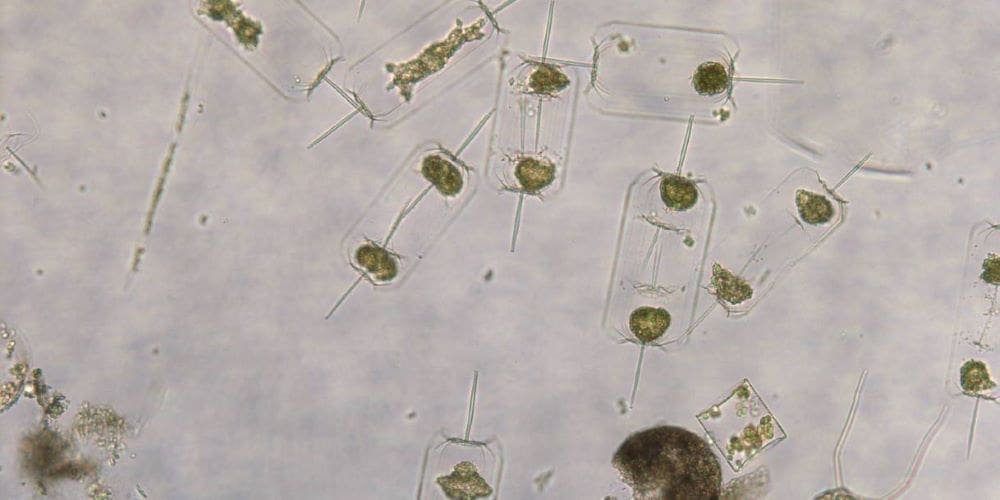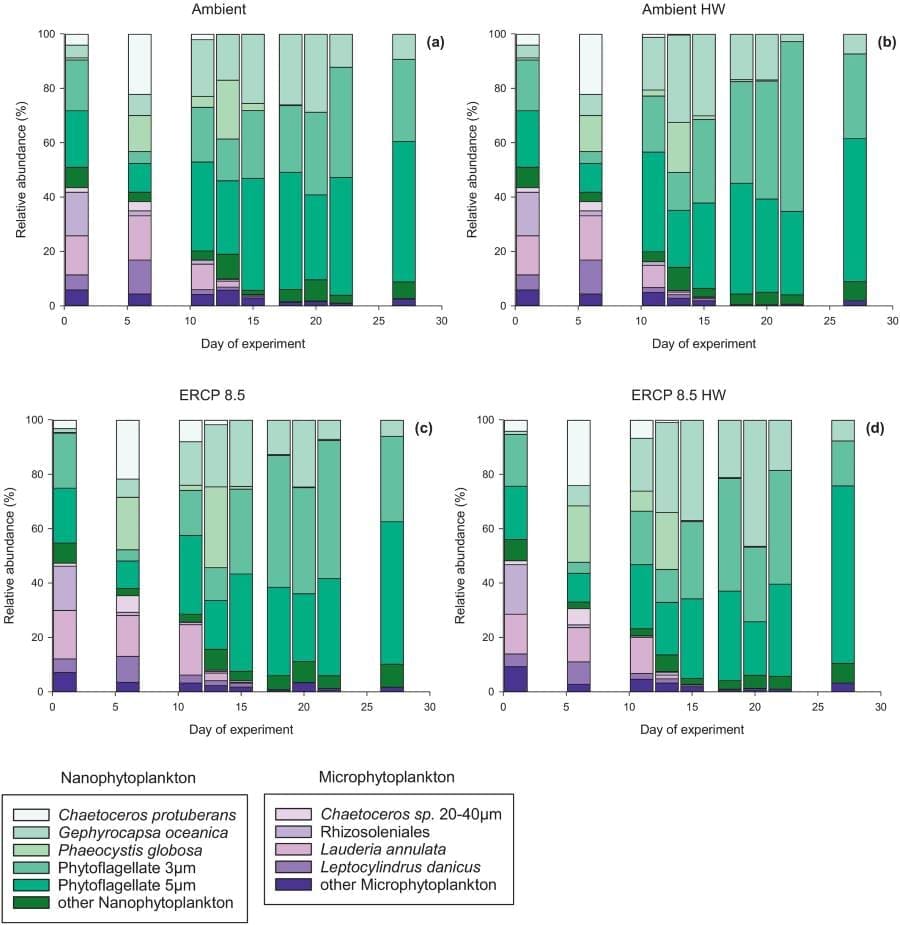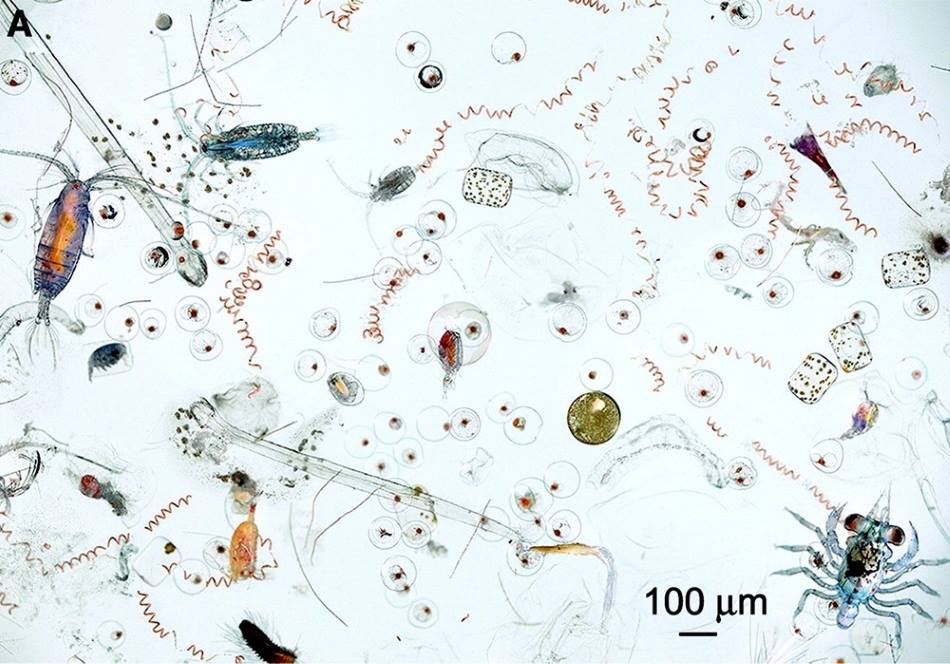Table of Contents
Summary:
Rising ocean temperatures are reshaping the North Sea ecosystem — and not just gradually. Marine heatwaves, which cause sudden spikes in water temperature, are intensifying changes in plankton communities that already face pressure from long-term climate trends. Researchers from the Alfred Wegener Institute’s Marine Station Helgoland have published a trio of studies examining how both sustained warming and short-term extreme events affect plankton, the base of the marine food web in the German Bight.
Their work draws on decades of ecological data and new experimental findings. In one study2 published in the Journal of Animal Ecology, scientists analysed historical records from the Helgoland Roads time series, revealing that marine heatwaves have become more frequent and prolonged since the 1990s. Two additional studies1,3, published in Limnology and Oceanography, examined present and future scenarios, including simulated heatwaves under high-emissions conditions.
The results show that warming alone shifts species composition, but the addition of heatwaves accelerates those changes — reducing total biomass in zooplankton, altering bacterial communities, and favouring smaller phytoplankton. “Marine heatwaves impact organisms at the basis of the food web,” says Dr Cédric Meunier. “This could have consequences for higher levels, such as fish.”

Marine heatwaves pose problems for coastal plankton
Temperatures around the world continue to rise – and the North Sea is no exception. Yet, in addition to this gradual warming, increasingly frequent and intense heat events also have consequences for marine organisms. Researchers at the Marine Station Helgoland, a research facility of the Alfred Wegener Institute, have quantified the frequency and intensity of these heatwaves along with their repercussions for plankton.
They have also conducted an experiment that exposed the North Sea plankton community to different future warmer scenarios, both with and without heatwaves. The researchers found that gradual warming causes significant shifts in the species spectrum. When heatwaves are added, however, these alterations are amplified. The results have been published in three publications, most recently in Limnology and Oceanography.
From rising sea levels and new introductions of species to a temperature increase of 1.9 °C since 1962, there is clear evidence that the North Sea is changing more rapidly at present than it has for millennia. Yet, given that climate change takes place over long timescales – from a human perspective, at least – these changes can seem slow and gradual, perhaps not so serious, because many organisms might adapt gradually. “This puzzle, however, misses a key piece,” says Dr Cédric Meunier. “And that’s marine heatwaves.”
Meunier researches the ecology of shelf sea systems at the Marine Station Helgoland (BAH), which became part of the Alfred Wegener Institute Helmholtz Centre for Polar and Marine Research (AWI) in 1998. In collaboration with researchers from various disciplines, Meunier has focused on marine heatwaves and their potential impact on plankton.
During these periods of intense heat, water temperatures rise suddenly – usually as a result of a preceding atmospheric heatwave – and remain well above average temperatures for several days. Given their abruptness and intensity, researchers aimed to determine how these heatwaves impact organisms. They have analysed historical measurement data, examined the frequency and intensity of heatwaves over recent decades through to the present day, and conducted an experiment looking at the future of the North Sea ecosystem.
Their results have been published in two research papers: one focuses on the past, while the other deals with the present. A third paper has now been published and completes the cycle by focusing on the future impact of these heatwaves.
The researchers’ historical analysis was made possible by Helgoland Roads, one of the world’s longest and most detailed ecological time series. Thanks to the tireless efforts of numerous researchers, the Helgoland Roads time series seamlessly documents the North Sea pelagic ecosystem since 1962. In their analysis of temperature data, ecologist Dr Luis Gimenez and his colleagues identified that marine heatwaves have occurred more frequently in the German Bight over recent decades, through to the present day – and last longer, too. These heatwaves are more common in late summer, when average temperatures in the annual cycle are at their highest.
A second study showed that heatwaves have already exerted a significant impact on organisms. “We have identified substantial changes in medium-sized zooplankton, including copepods, as a result of temporary temperature increases,” explains Margot Deschamps, another BAH researcher. “Some groups were decimated after a heatwave, at least temporarily, while others appeared to benefit and proliferate.”
In the third research article, now published in Limnology and Oceanography, the research team investigate future potential changes. They relied on one of the world’s most advanced mesocosm facilities at the AWI Wadden Sea Station on Sylt. Each of the 30 cylindrical tanks (mesocosms) is 85 centimetres tall, 170 centimetres wide and holds about 1,800 litres of sea water. By making targeted adjustments to the water’s temperature, pH value and nutrient content, researchers are able to simulate the conditions in the world of tomorrow. As such, the mesocosms act as time machines, transporting the plankton within them into the future.

In this experiment, the research team exposed plankton from the North Sea to both current conditions and the conditions projected by RCP 8.5 – a “business as usual” scenario defined by the Intergovernmental Panel on Climate Change (IPCC). In this scenario, the global community’s CO2 emissions would continue to rise to over 100 gigatons by 2100, which could lead to a global temperature increase of 4 to 5 °C. Current conditions and “business as usual” RCP 8.5 conditions were simulated both without and with 5-days-long heatwaves which warmed the water by 2 °C above average.
“The results indicate that climate change may cause shifts at many levels within the plankton community, which are further amplified or modified by heatwaves,” explains Meunier. “Certain bacterial groups benefit from these environmental changes, including some bacteria from the genus Vibrio, which are potentially dangerous to humans. While the total biomass of phytoplankton remains constant in the RCP 8.5 scenario, the composition of species shifts in favour of smaller species.
“The additional impact of heatwaves particularly benefits coccolithophores, which feature a calcium carbonate shell, and phytoflagellates. Even stronger shifts occur in zooplankton communities. We observe a reduction in total biomass under warmer conditions, especially regarding medium-sized mesozooplankton. Additional heatwaves have a particularly negative impact on Noctiluca scintillans, a species known for its bioluminescence.”
Taken as a whole, the three research papers emphatically demonstrate the vast changes in species communities of North Sea plankton resulting from continued global temperature increases. However, focussing solely on average temperatures is not sufficient for ecological forecasts. This is because short-term events, such as heatwaves, can modify, and potentially further amplify these effects.
“With this in mind, it is important to keep an eye not only on long-term climate trends but also on short-term events, like heatwaves,” says Cédric Meunier. “Marine heatwaves impact organisms at the basis of the food web. This could have consequences for higher levels, such as fish.”
Journal Reference:
(1) Luis Giménez, Maarten Boersma, and Karen H. Wiltshire, ‘A multiple baseline approach for marine heatwaves’, Limnology and Oceanography 69, 3 (2024). DOI: 10.1002/lno.12521
(2) Margot Deschamps, Maarten Boersma, Luis Giménez : ‘Responses of the mesozooplankton community to marine heatwaves: Challenges and solutions based on a long‐term time series’, Journal of Animal Ecology 93, 10 (2024). DOI: 10.1111/1365-2656.14165
(3) Cédric L. Meunier, Josefin Schmidt, Antonia Ahme, Areti Balkoni, Katharina Berg, Lea Blum, Maarten Boersma, Jan D. Brüwer, Bernhard M. Fuchs, Luis Gimenez, Maïté Guignard, Ret al., ‘Plankton communities today and tomorrow — potential impacts of multiple global change drivers and marine heatwaves’, Limnology and Oceanography (2025). DOI: 10.1002/lno.70042
Article Source:
Press Release/Material by Alfred Wegener Institute, Helmholtz Centre for Polar and Marine Research (AWI)
Featured image: Marine microplankton, part of the contents of one dip of a hand net, photographed on board the NOAA Ship Oscar Elton Sette off Kona, September 20, 2006. The image contains diverse planktonic organisms, ranging from photosynthetic cyanobacteria and diatoms to many different types of zooplankton, including both holoplankton (permanent residents of the plankton) and meroplankton (temporary residents of the plankton, e.g., fish eggs, crab larvae, worm larvae) (image courtesy David Liittschwager). Credit: Nadeau et al. (2016) | DOI: 10.1089/ast.2015.1376 | Astrobiology | CC BY 4.0




